Freiburg in Breisgau is a charming city in the heart of Germany's Black Forest, renowned for its medieval architecture, vibrant culture and stunning natural surroundings. Despite heavy bombing during World War II, the city centre was rebuilt according to its original medieval plans. With its proximity to the Black Forest, Freiburg provides easy access to scenic mountain recreation areas. The city has a thriving population of approximately 200,000 residents, including 30,000 students, and is home to one of Germany’s oldest universities. Even with just one day to explore, you can still enjoy the highlights of this captivating city.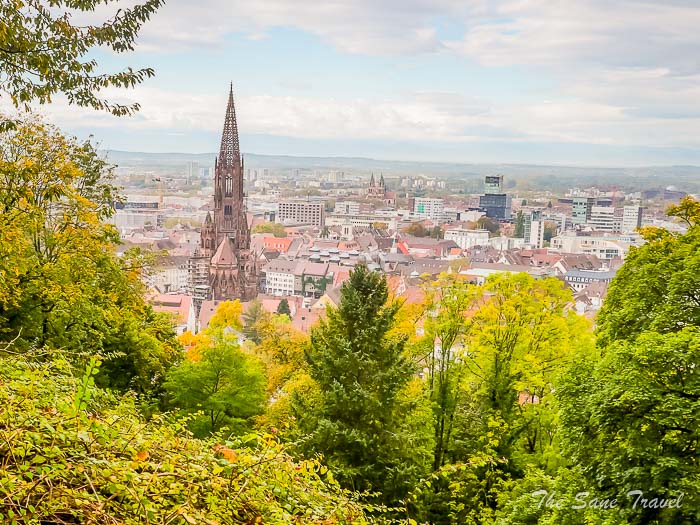
Bachle
The Bachle, a distinctive feature of Freiburg, are a fascinating sight throughout the city. These narrow water channels, constructed around 600 years ago, originally supplied water from the river Dreisam for drinking, firefighting and other purposes. The channels are shallow and roughly the width of a car tyre. Additionally, the clean water flowing from the Dreisam plays a key role in cooling the city's urban microclimate.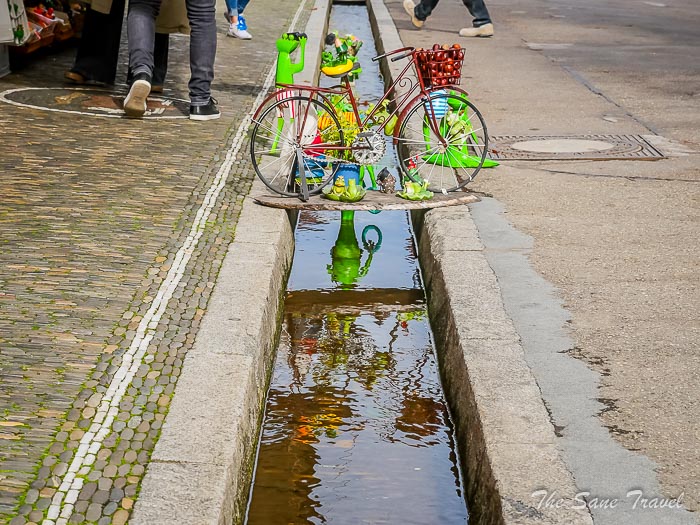
Old Town Hall
Construction of the Old Town Hall was finished in 1559, but it was destroyed by fire during a bombing raid in 1944, leaving only the outer walls intact. During reconstruction, three new wings were added, and red sandstone was used for the facade. The tradition of the painted facade was preserved in the gable, which features a double-headed eagle of the Holy Roman Empire above the clock. Today, the Tourist Information Office is located on the ground floor of the Old Town Hall.
Martinskirche
In 1206, a chapel was constructed on the site where St Martin Church now stands. It was later expanded into a monastery by the Franciscans in the 13th century. According to legend, the monk Berthold Schwarz is said to have invented gunpowder there in the 14th century. In 1851, a monument to Schwarz was erected on what is now Rathausplatz, in front of the former Franciscan Church.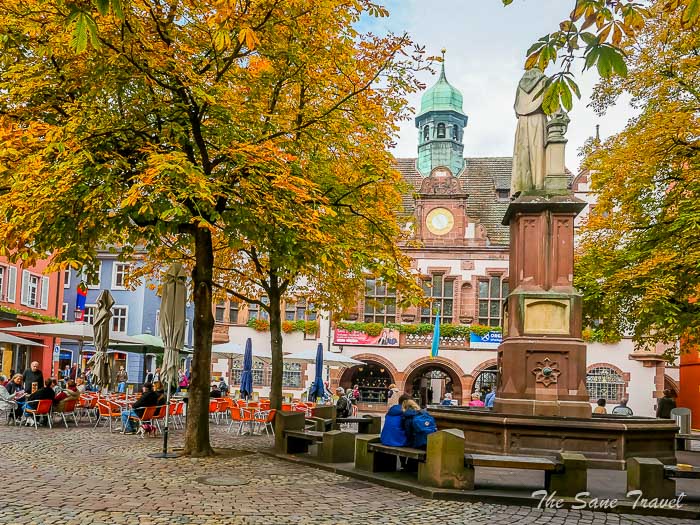 The church sustained severe damage during an air raid in November 1944, leaving only the outer walls of the aisles and the western gable intact. Reconstruction began in 1949 and was completed in 1951, with further renovations in the 1970s.
The church sustained severe damage during an air raid in November 1944, leaving only the outer walls of the aisles and the western gable intact. Reconstruction began in 1949 and was completed in 1951, with further renovations in the 1970s. 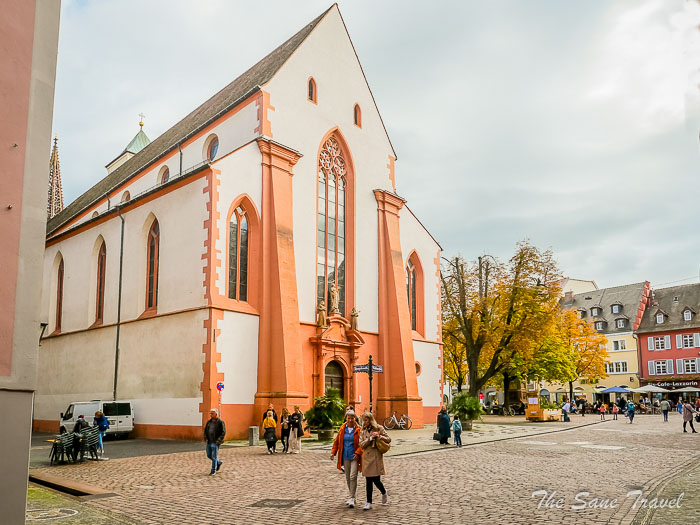 The church's stunning stained glass windows create a vibrant display of colours when sunlight shines through, adding to the spiritual ambience.
The church's stunning stained glass windows create a vibrant display of colours when sunlight shines through, adding to the spiritual ambience.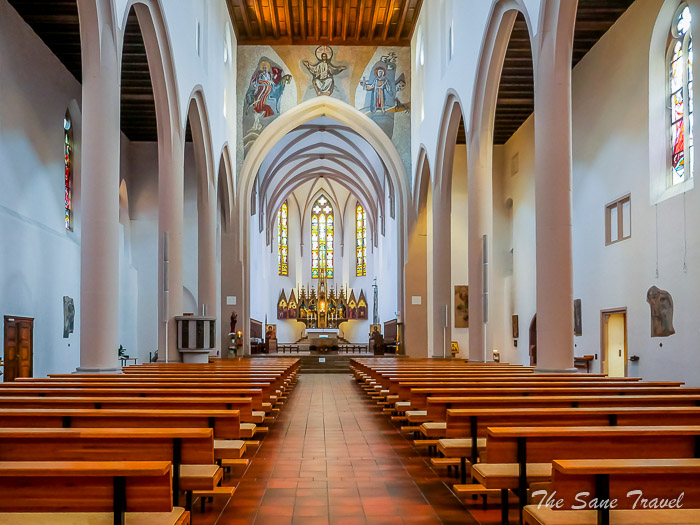 The convent also hosts a variety of cultural events and exhibitions, contributing to the lively community life in Freiburg.
The convent also hosts a variety of cultural events and exhibitions, contributing to the lively community life in Freiburg.
Unterlinden Square
Constructed in 1806, Unterlinden Square is approximately 100 metres from the Old Town Hall. At that time, much of the square was occupied by the former Freiburg Dominican monastery. The neo-baroque Unterlinden Fountain, featuring a statue of the Virgin Mary, was crafted in 1890 by the renowned Freiburg sculptor Julius Seitz. Positioned beneath a linden tree, the fountain and a late Gothic crucifix salvaged from the monastery's wall are the only remaining physical reminders of the devastation caused by the bombing of Freiburg.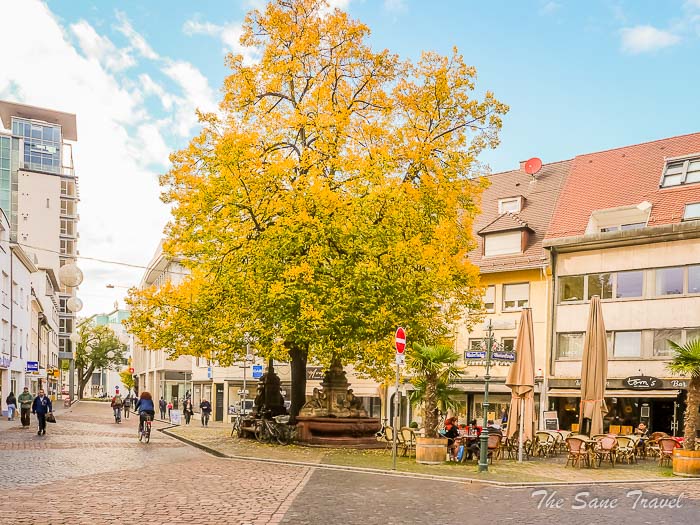
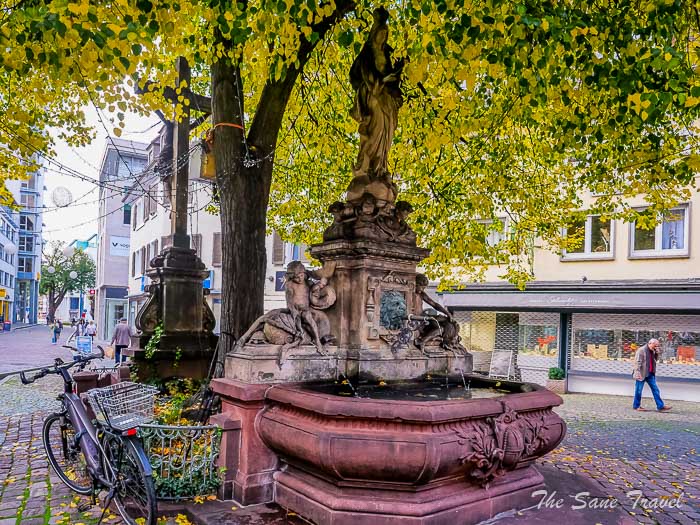
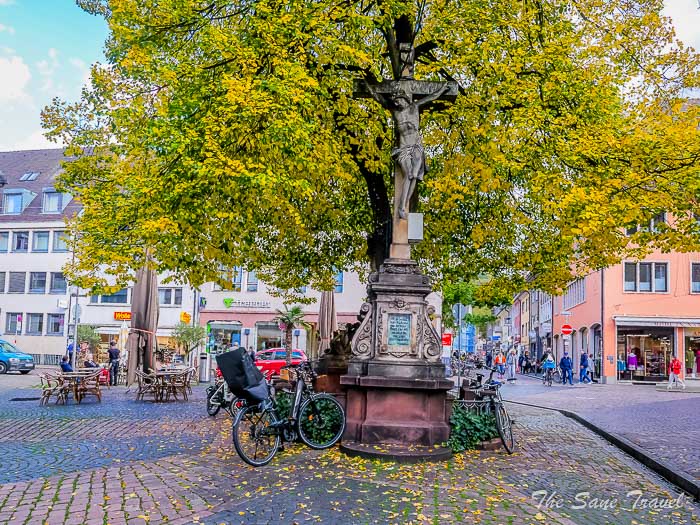 Nowadays, Unterlinden Square offers a pleasant environment for visitors, with various shopping opportunities available.
Nowadays, Unterlinden Square offers a pleasant environment for visitors, with various shopping opportunities available.
Victory Monument
The Victory Monument (Siegesdenkmal) commemorates the German success in the Franco-Prussian War of 1871. Following the victories against the French, the citizens of Baden raised funds to construct a monument celebrating their triumph. Sculptor Karl Friedrich Moest was selected through a public competition to design the monument, which was crafted from French gun barrels and unveiled in 1876. At the top of the pedestal adorned with inscriptions and depictions of war heroes stands Victoria, the goddess of victory, holding a laurel wreath aloft in a gesture of pride.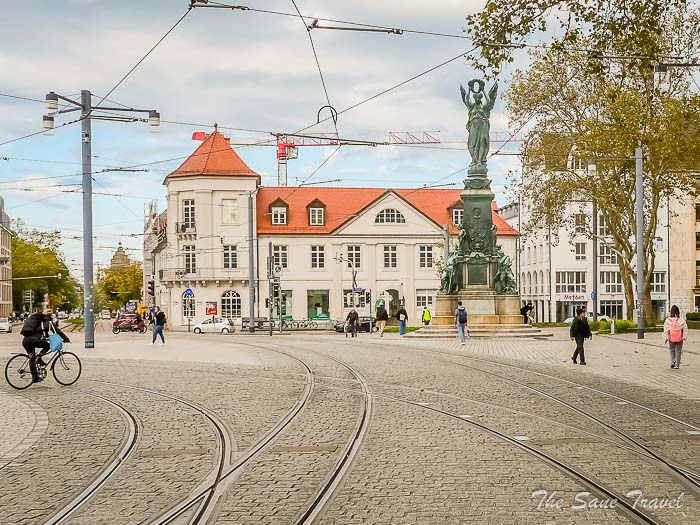
Rau Fountain
The Raubrunnen, or Rau Fountain, was officially presented to the city in 1911 as a donation from Commercial Councillor Rau, who was celebrating his 25th anniversary as city council chairman. The fountain, designed in Gothic style, features a bronze sculpture by Kubaneck, depicting an old German bourgeois girl carrying two buckets of water on a pole, accompanied by four children holding flowers and fruit.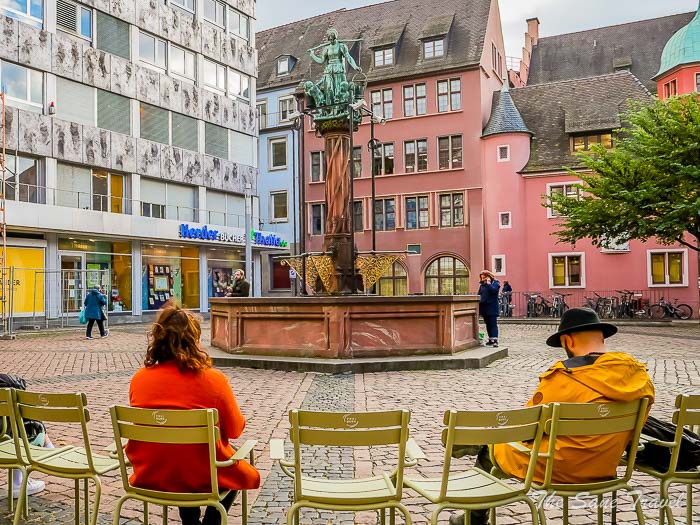
Freiburg Cathedral
The Freiburg Minster, also known as Freiburg Cathedral, is a prominent symbol of the city and one of the most impressive churches in the Black Forest region. Construction of the cathedral began around 1200 in the late Romanesque style and continued in the Gothic style, taking nearly 300 years to complete.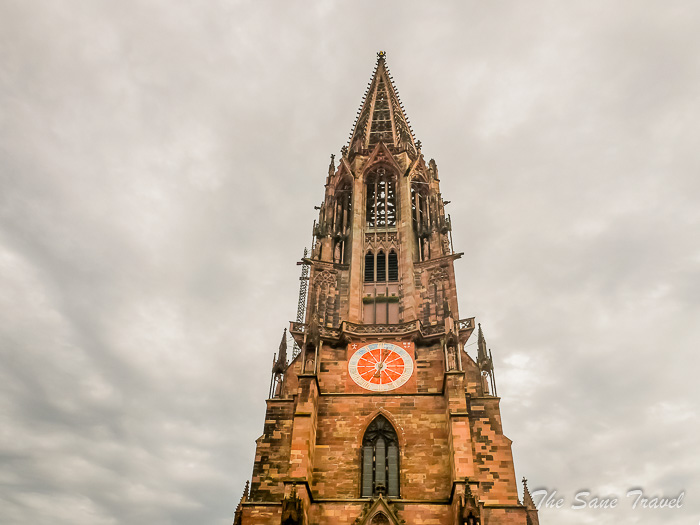 The cathedral's main entrance is unique, featuring a grand pointed-arch portal on the west side of the tower. The exterior main portal is adorned with intricate carvings that showcase the skilled craftsmanship of Freiburg's stonemasons. The interior is equally striking, with walls adorned with biblical and allegorical figures set within beautiful pointed-arch architecture.
The cathedral's main entrance is unique, featuring a grand pointed-arch portal on the west side of the tower. The exterior main portal is adorned with intricate carvings that showcase the skilled craftsmanship of Freiburg's stonemasons. The interior is equally striking, with walls adorned with biblical and allegorical figures set within beautiful pointed-arch architecture. 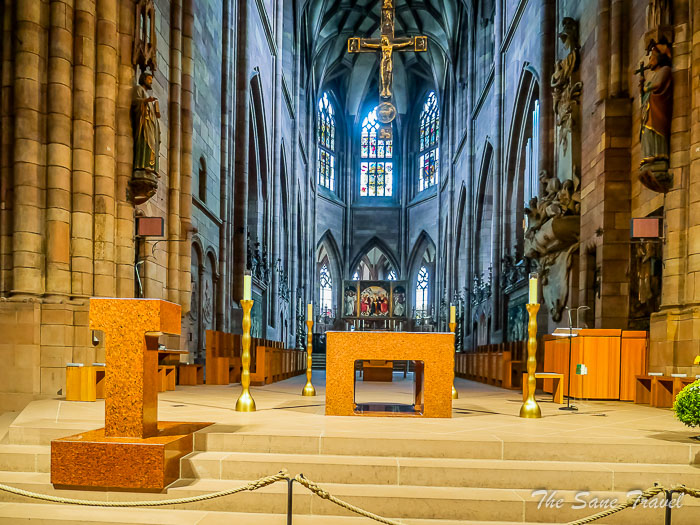
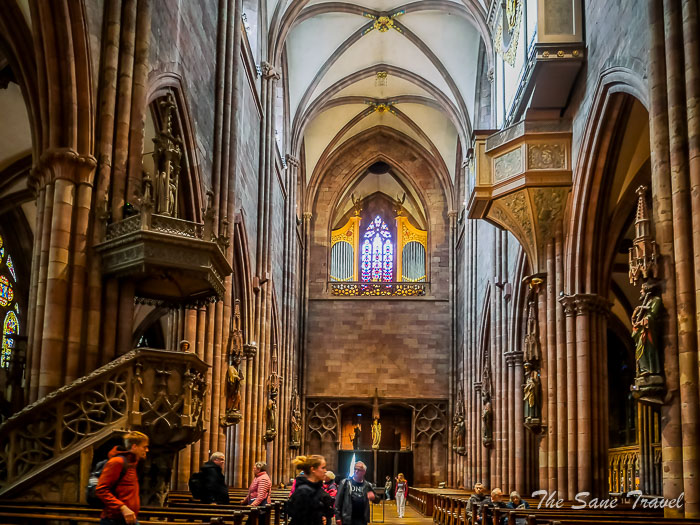
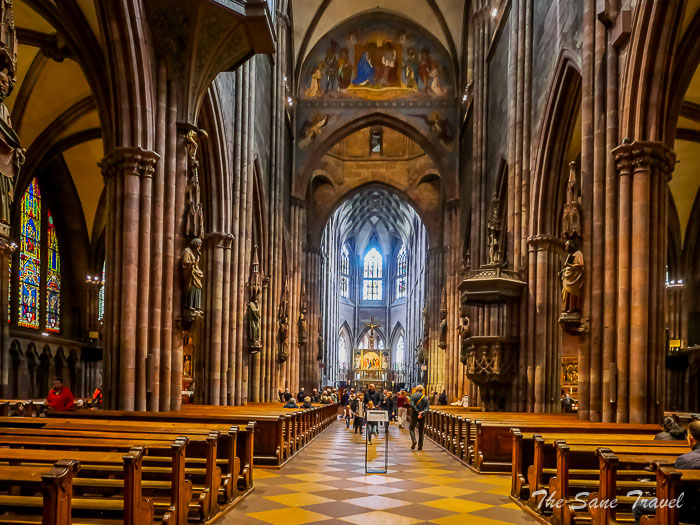 Notable features include the high altar by Hans Baldung Grien and another altar by Hans Holbein. The cathedral's 116-metre-high tower, completed in the Middle Ages, is often praised as 'the most beautiful tower in Christendom' and offers visitors a panoramic view of the city when climbed.
Notable features include the high altar by Hans Baldung Grien and another altar by Hans Holbein. The cathedral's 116-metre-high tower, completed in the Middle Ages, is often praised as 'the most beautiful tower in Christendom' and offers visitors a panoramic view of the city when climbed.
Market at Cathedral Square
Cathedral Square, encircled by charming buildings, is the most spacious square in the city. On weekdays, a market takes place in the square from 7:30 to 13:30. General merchants sell their products on the southern side, while local producers offer seasonal fruits and vegetables on the northern side. Be sure to try the street food available there!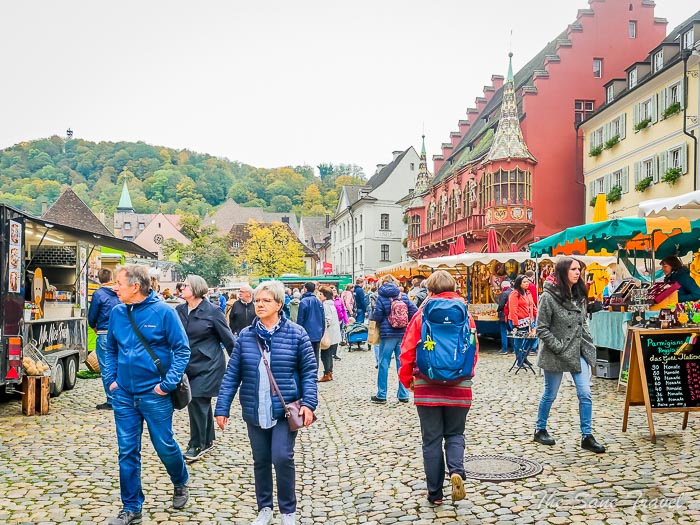
Merchants’ Hall
The Historic Merchants' Hall, known as Historisches Kaufhaus in German, is one of the oldest buildings in Freiburg. Standing on Cathedral Square since 1520, the building exudes a rich history from every corner. Its beautifully renovated rooms provide a distinctive setting for events such as conferences and receptions.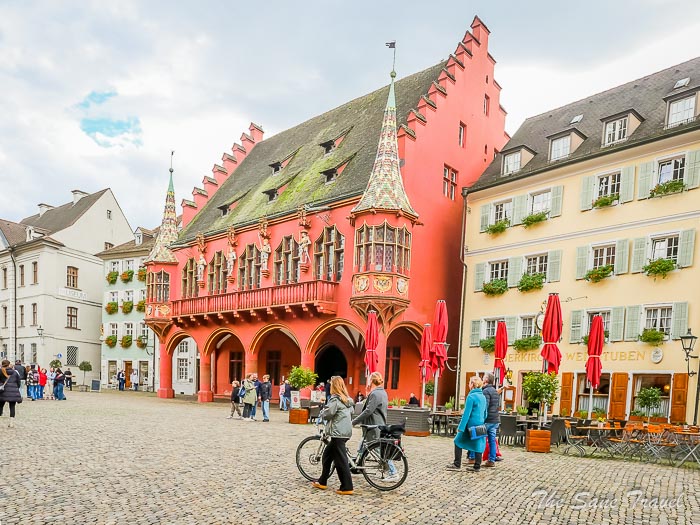
Kornhaus
The Kornhaus, located on the northwestern corner of the square, is a notable historic building. Originally planned for completion in time for King Maximilian I's visit in 1498, the guild and dance hall were not finished as expected. Despite this, the Kornhaus was still used for dancing and celebrations after its completion. It served as a theatre from 1770 to 1824 before being used as a grain storage facility for merchants until World War II. In the late 20th century, the building was reconstructed. Today, it houses the Centre Culturel Francais, an ice cream parlour and several shops.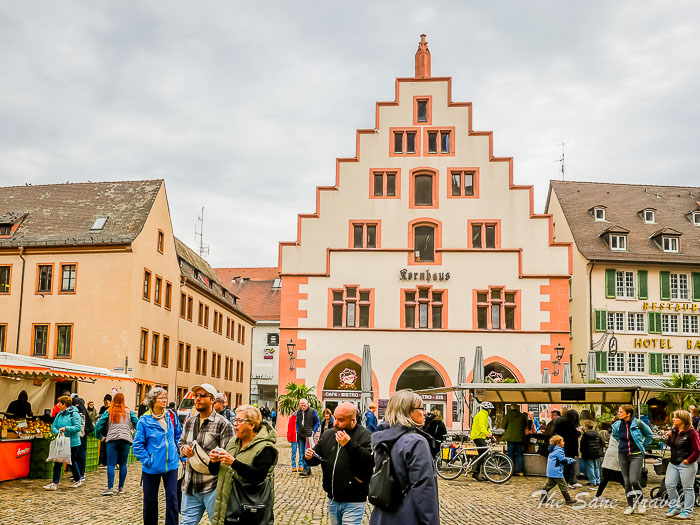
Schlossberg
Castle Hill in Freiburg, known as Schlossberg in German, is a must-see attraction just behind the Old Town. Its forested peak is easily visible while exploring the city, offering stunning views and opportunities for peaceful hikes. The area is rich in history, with remnants of Baroque walls, the Bismarck Tower, dating back to 1906, and Cannon Square. Originally the site of a fortified castle built by dukes nearly a thousand years ago, Schlossberg has been home to various rulers, including the Counts of Freiburg, the Habsburgs and the French occupiers, who incorporated the medieval castle into the city's fortifications in the 17th century.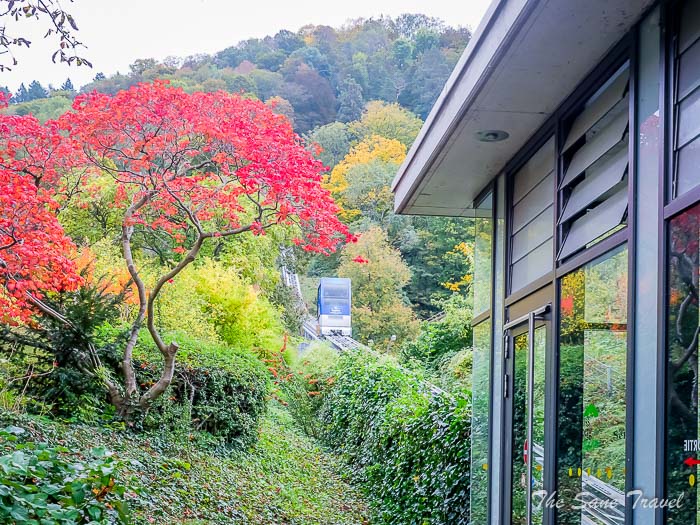
Schlossberg Bahn
The Schlossbergbahn offers a quick three-minute ride from the city centre to a stunning lookout point. Once there, visitors can explore walking trails, dine at a restaurant and climb the tower for even better views. Starting from Stadtgarten, the Schlossbergbahn accommodates up to 25 passengers on its 262-metre journey up the Schlossberg, completing the route in about three minutes.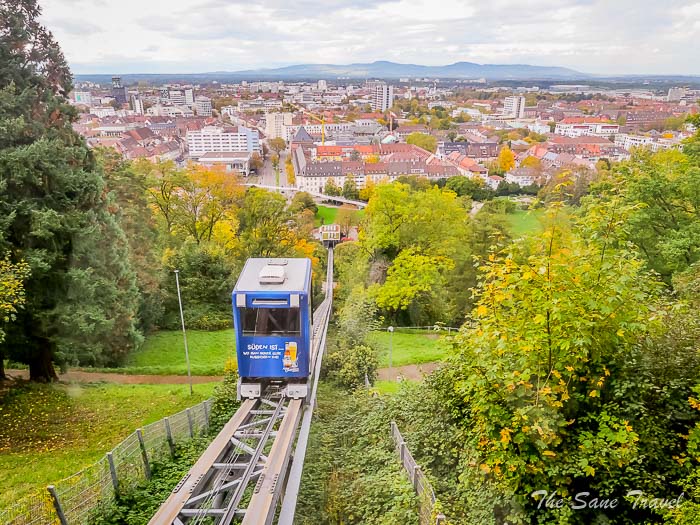
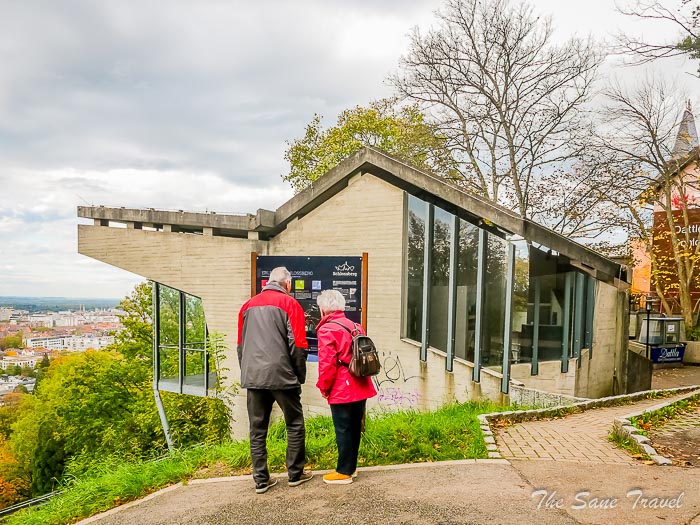
On top of Schlossberg
Visitors can reach Kanonenplatz, perched atop the former Vauban fortifications, just in few minutes from the upper station of the Schlossbergbahn.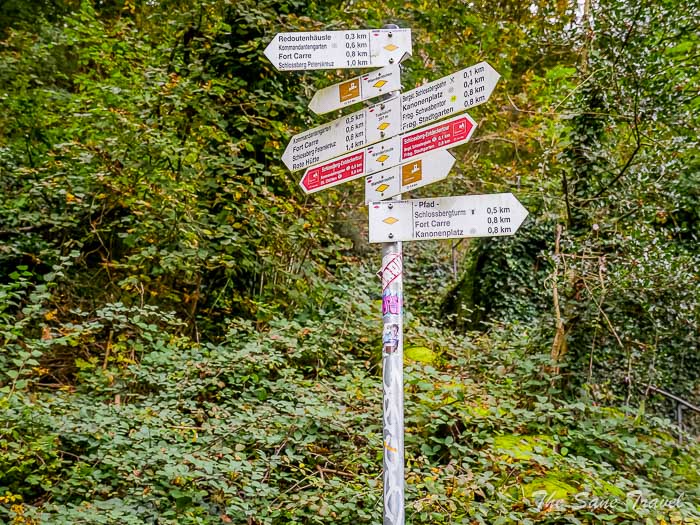 Instead of cannons, the area is now equipped with telescopes, allowing visitors to enjoy stunning views. The panoramic vista encompasses the city and the nearby cathedral, extending to the Vosges mountains in France and across the Rhine Valley plain on clear days.
Instead of cannons, the area is now equipped with telescopes, allowing visitors to enjoy stunning views. The panoramic vista encompasses the city and the nearby cathedral, extending to the Vosges mountains in France and across the Rhine Valley plain on clear days.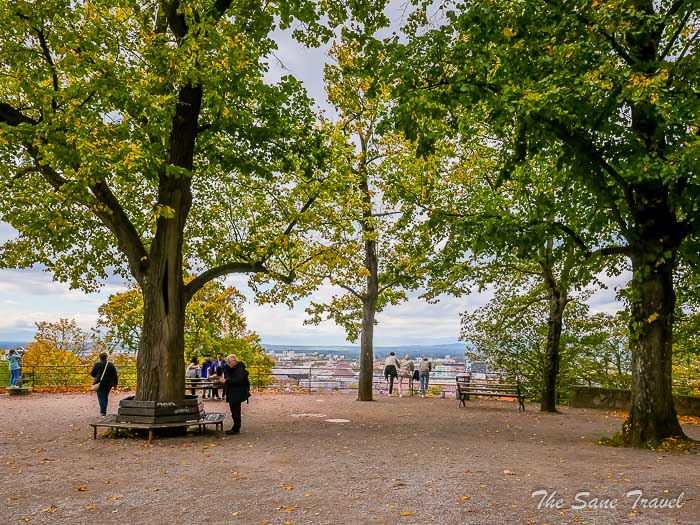
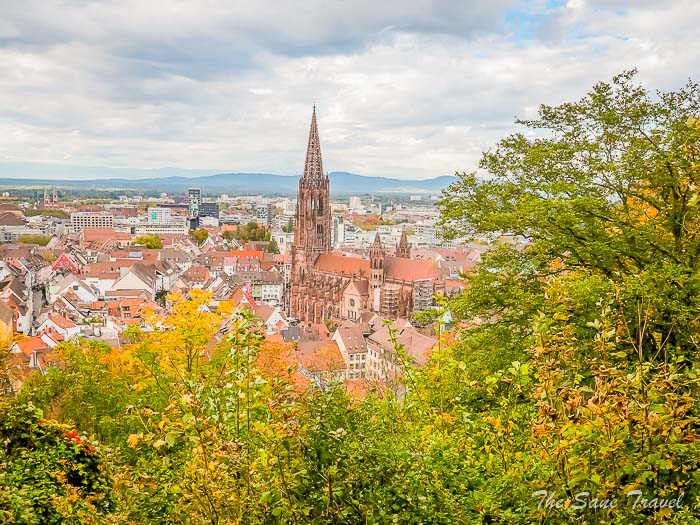 For an even more expansive view, visitors can climb the stairs to the top of the 35-metre-high observation tower, which was primarily funded by donations.
For an even more expansive view, visitors can climb the stairs to the top of the 35-metre-high observation tower, which was primarily funded by donations. 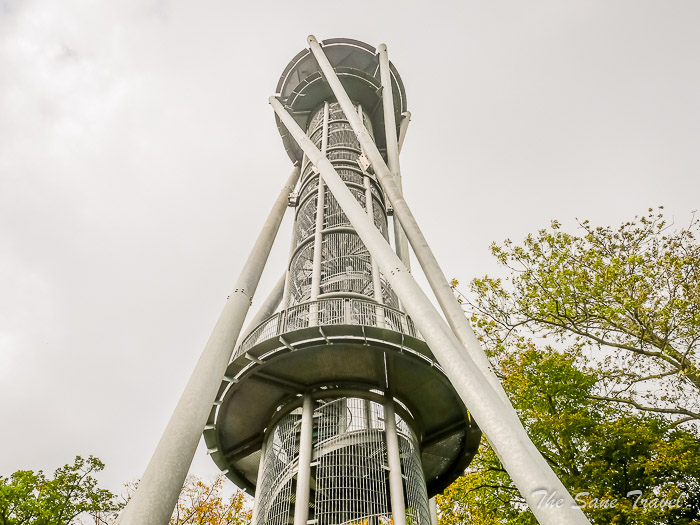 The names of all donors are displayed on the front steps of the tower.
The names of all donors are displayed on the front steps of the tower.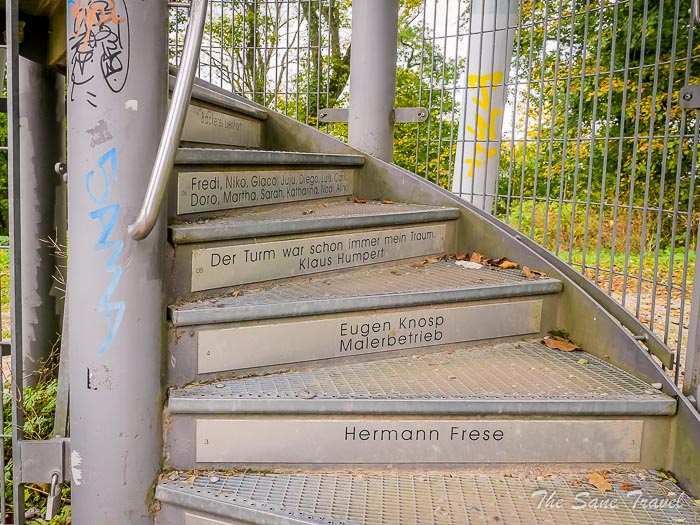 From the top, approximately 200 metres above Freiburg, visitors can admire the unique view of the city, green valleys, vineyards and rivers of the Breisgau region.
From the top, approximately 200 metres above Freiburg, visitors can admire the unique view of the city, green valleys, vineyards and rivers of the Breisgau region.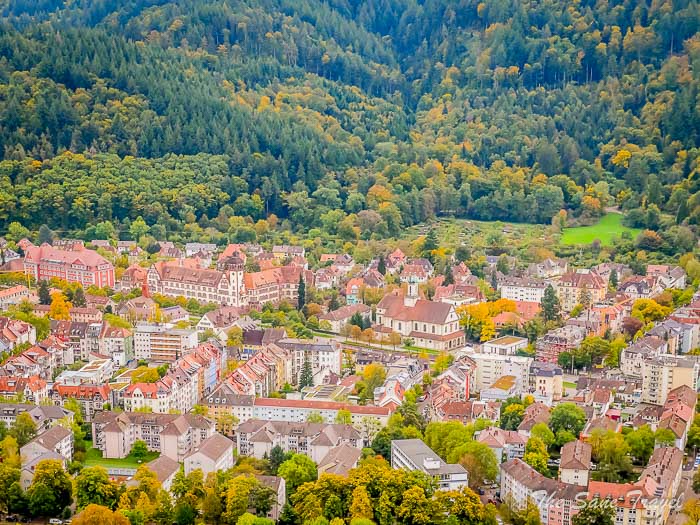
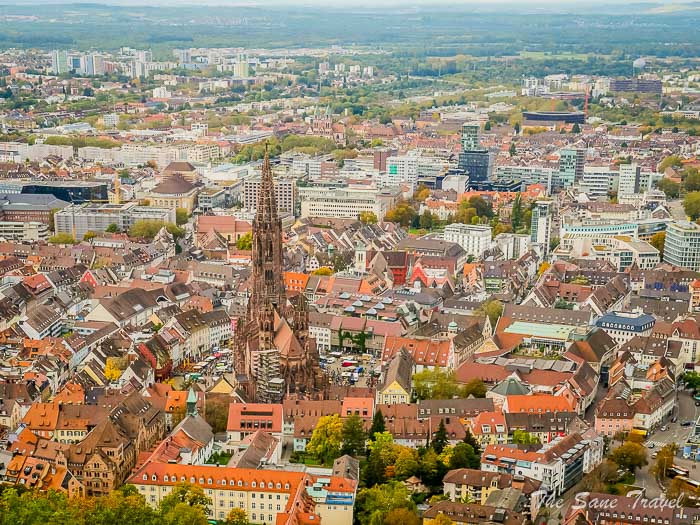
Two historic city gates
Two of the original city gates in Freiburg, the Schwabentor (Swabian Gate) and the Martinstor, are the only ones still standing.While the exact age of the Schwabentor is unknown, it is believed to date back to the mid-13th century. Legend has it that a wealthy farmer from Swabia tried to buy Freiburg with barrels of money, only to be tricked by his wife, who filled them with sand instead. It is worth noting that Freiburg is located in Baden, not Swabia. The exterior wall of the gate features an image of St. George, the dragon slayer, who is the patron saint of Freiburg.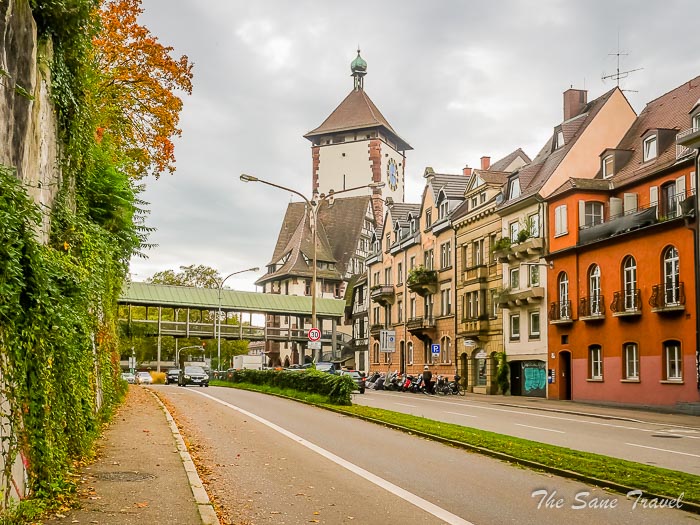
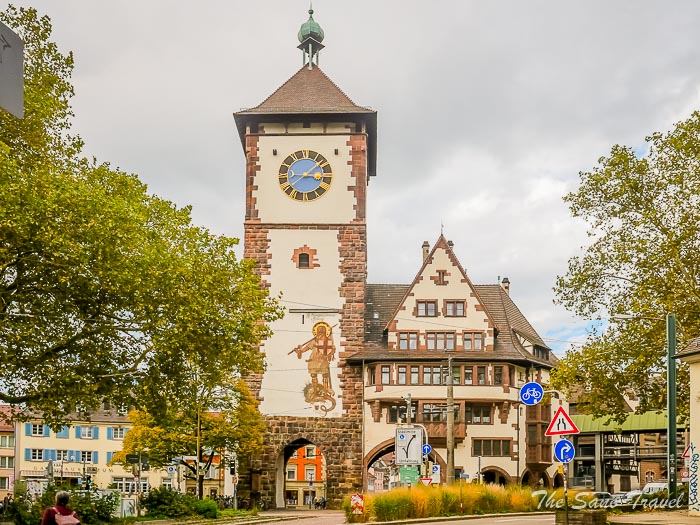
The Martinstor, located on Kaiser-Joseph-Strasse, is the older of the two and has been a part of Freiburg's cityscape for over eight centuries. Built in 1202 AD, it features a large forecourt, a bridge over a moat and remnants of battlements on its east side. 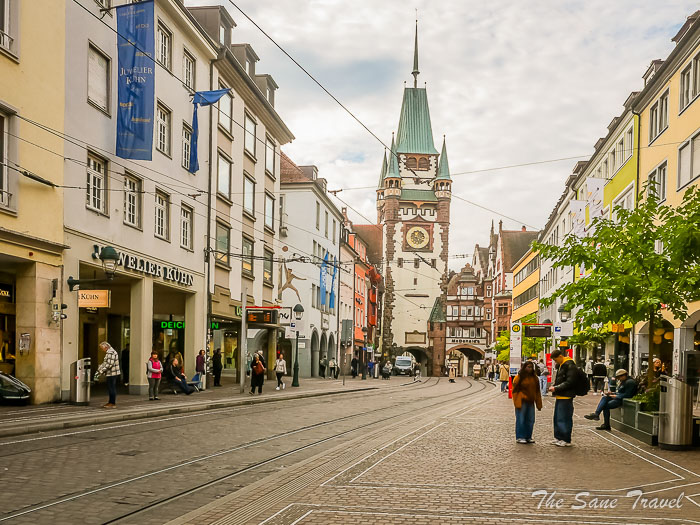
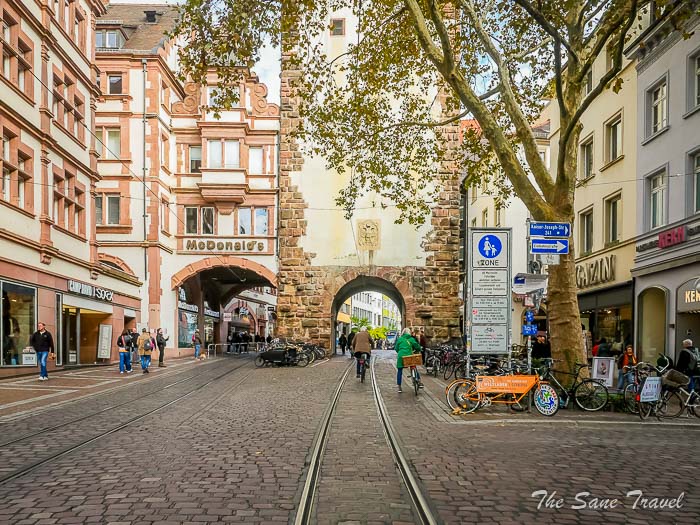
Bertoldsbrunnen
Bertoldsbrunnen, also known as Bertold's Fountain, is a monument dedicated to Freiburg's founder, Duke Bertold. Located in a small pool of water, it features a four-metre-high limestone pedestal topped with an abstract bronze equestrian statue. The fountain was unveiled in 1965, replacing the Fish Fountain, which was destroyed during World War II. Locals affectionately refer to it as 'Berti', although it is not a traditional fountain with spouts and a large basin. Situated at the intersection of Kaiser-Joseph-Strasse – Freiburg's main shopping street – and Salzstrasse, Bertoldsbrunnen is a popular meeting spot and a bustling centre of activity, thanks to its proximity to all five trolley car lines in the city.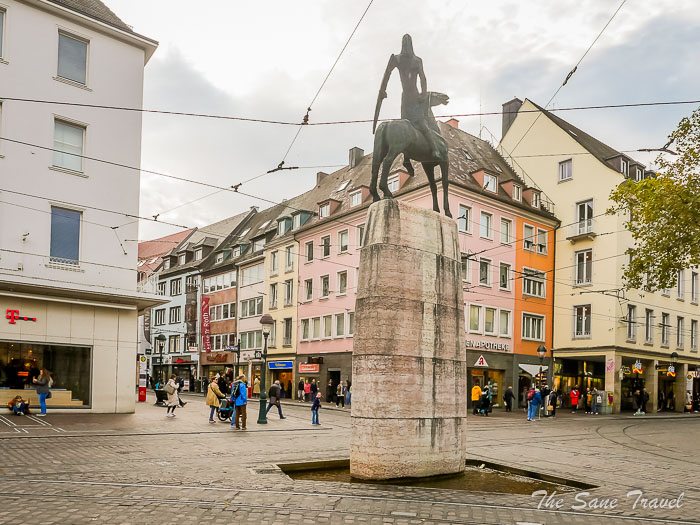
Vauban district
The Vauban district of Freiburg, located approximately 20 minutes from the city centre by public transport, spans 41 hectares. 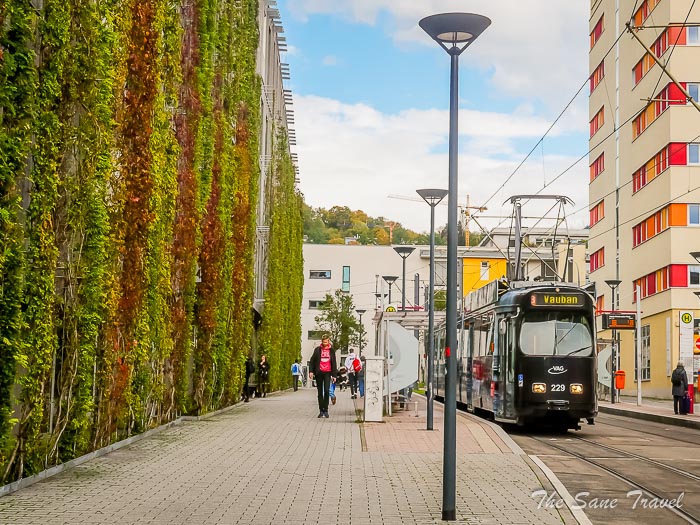 Originally established as a military base in 1936, it was later occupied by French forces after World War II until their departure in 1992. Afterwards, the vacant structures were inhabited by various groups of hippies and anarchists, some of whom were later granted rights to four of the twenty buildings. Today, visitors to Vauban can still see remnants of these alternative lifestyles in the side streets.
Originally established as a military base in 1936, it was later occupied by French forces after World War II until their departure in 1992. Afterwards, the vacant structures were inhabited by various groups of hippies and anarchists, some of whom were later granted rights to four of the twenty buildings. Today, visitors to Vauban can still see remnants of these alternative lifestyles in the side streets. 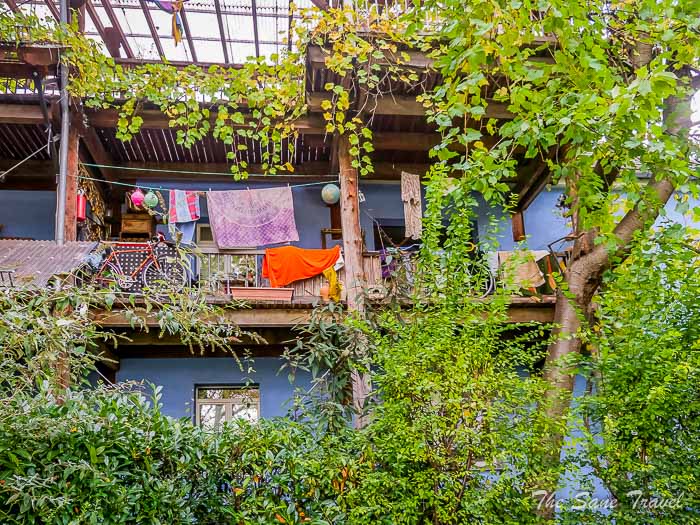
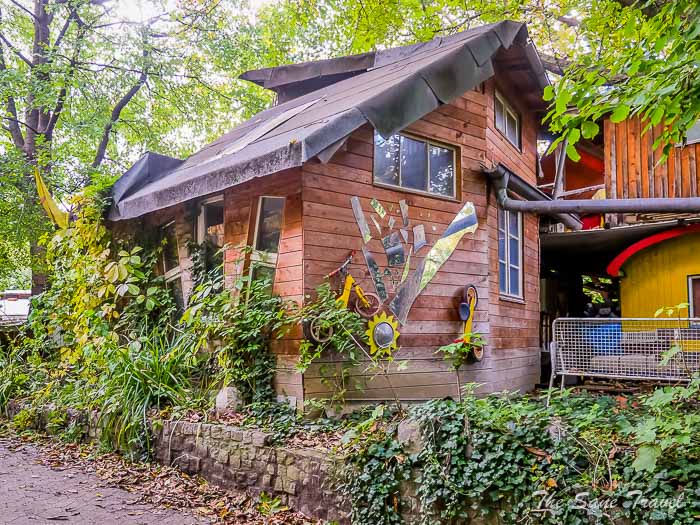
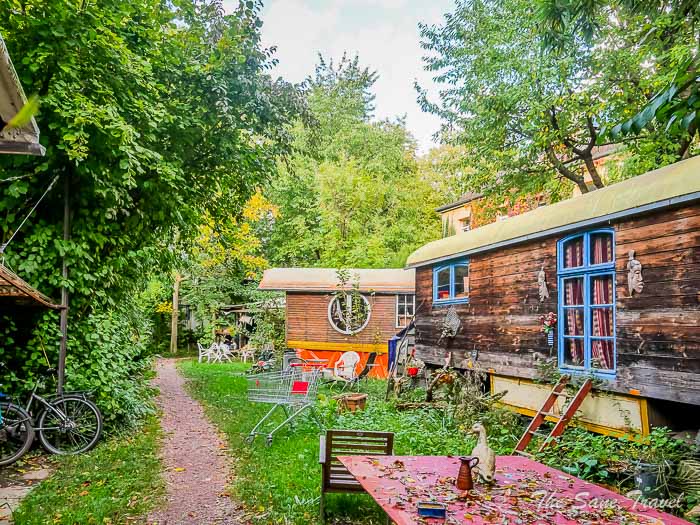 The remaining structures were demolished to make way for an eco-friendly town district focused on car-free living, spearheaded by dedicated residents. In Vauban, numerous homes are adorned with murals, adding vibrancy and charm to the area.
The remaining structures were demolished to make way for an eco-friendly town district focused on car-free living, spearheaded by dedicated residents. In Vauban, numerous homes are adorned with murals, adding vibrancy and charm to the area. 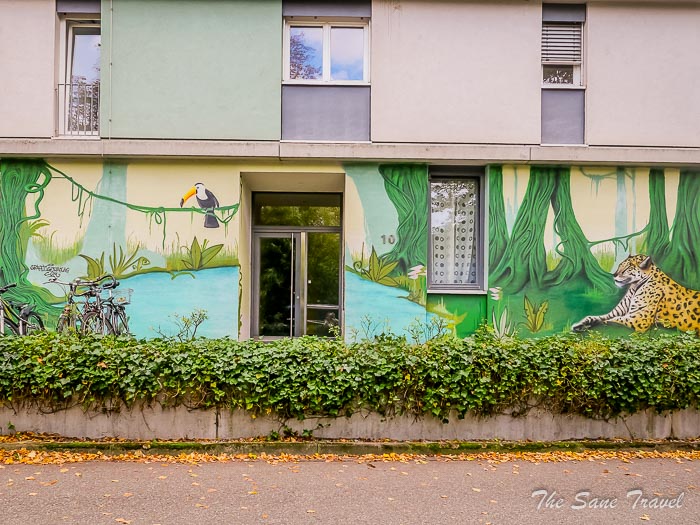
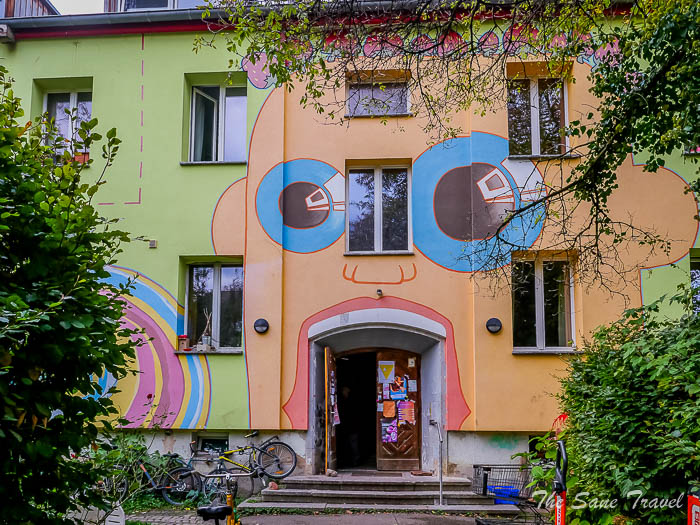
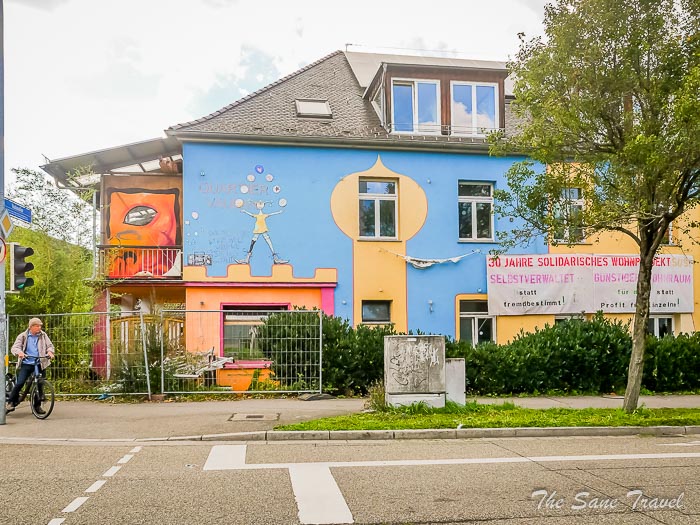 Vauban is well-known internationally as the 'green city,' with the 'Solar Settlement' showcasing a community powered by solar energy that generates more energy than it consumes.
Vauban is well-known internationally as the 'green city,' with the 'Solar Settlement' showcasing a community powered by solar energy that generates more energy than it consumes.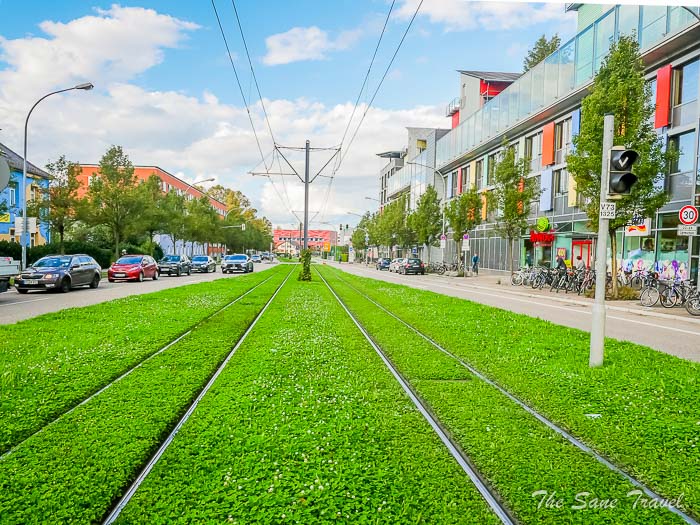
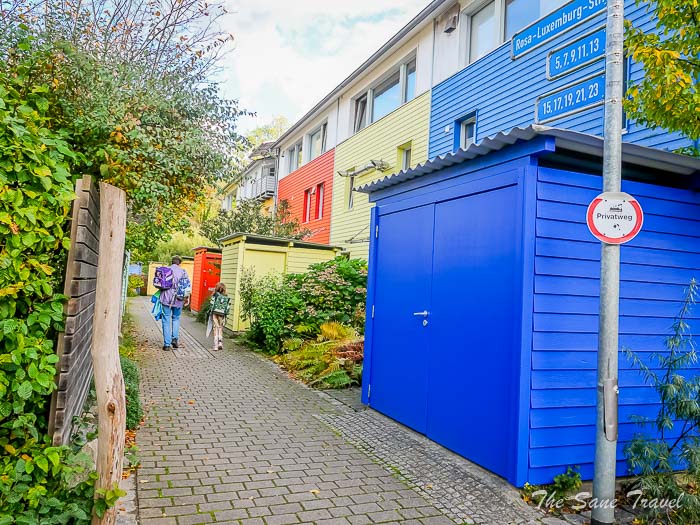
Just a few examples:
Green City Hotel Vauban
The hotel features contemporary architecture that meets both ecological and social standards. Over half of its staff members are individuals with mental or physical disabilities.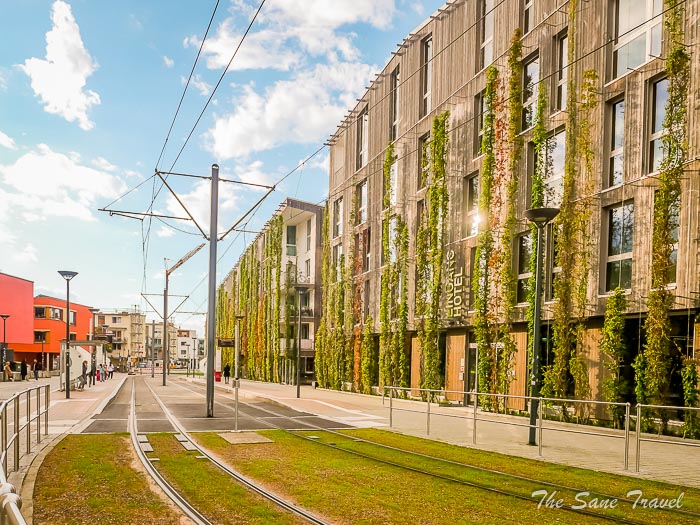
Vauban car parks
Solargarage and Glasgarage have been built in the district to provide parking for guests and residents living on car-free streets who own vehicles as part of the mobility concept. Both parking structures are equipped with solar panels.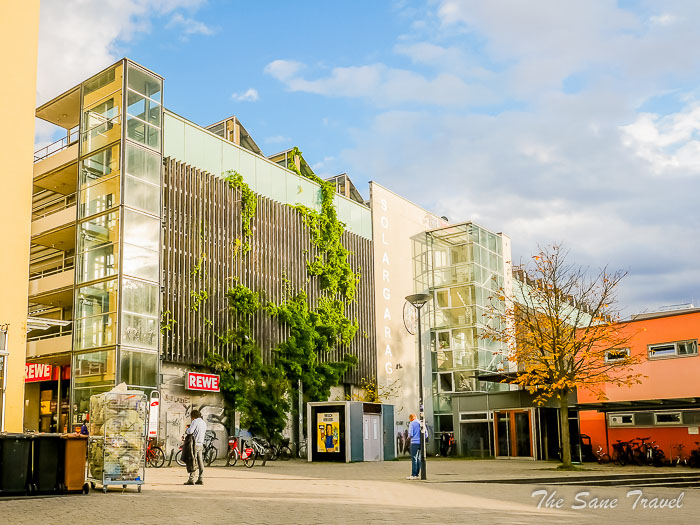
Walking tour map
The walking map enclosed in this guide provides a detailed route through the city centre, allowing for better planning of your walk. It outlines the sequence of sites mentioned in the article, starting with Rathaus Square and continuing to Schlossbergbahn station at Stadtgarten. From there, a short ride on the Schlossbergbahn takes you up to Schlossberg, where you can explore the area before descending the same way and continuing along the route to two historic towers. Next, head towards Bertoldsbrunnen and catch a tram to Vauban. After exploring Vauban, take a tram to the train station to conclude your tour.
Practical information
Freiburg, situated in Baden-Wurttemberg, Germany, close to the French border, makes for a pleasant day trip from Colmar, France. To reach Freiburg by public transportation, take a bus to Breisach and then transfer to a train, with the whole ride taking approximately 1.5 hours. Feiburg is also easily accessible from Basel, Switzerland, just 40 minutes away, and from Stuttgart, which is a 2-hour journey. Wear comfortable walking shoes as some paths on top of Schlossberg can be uneven and stony.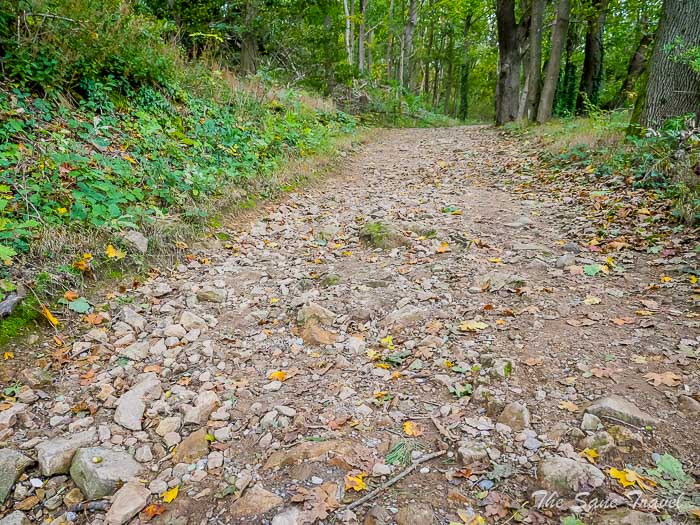
Like it? Pin it!
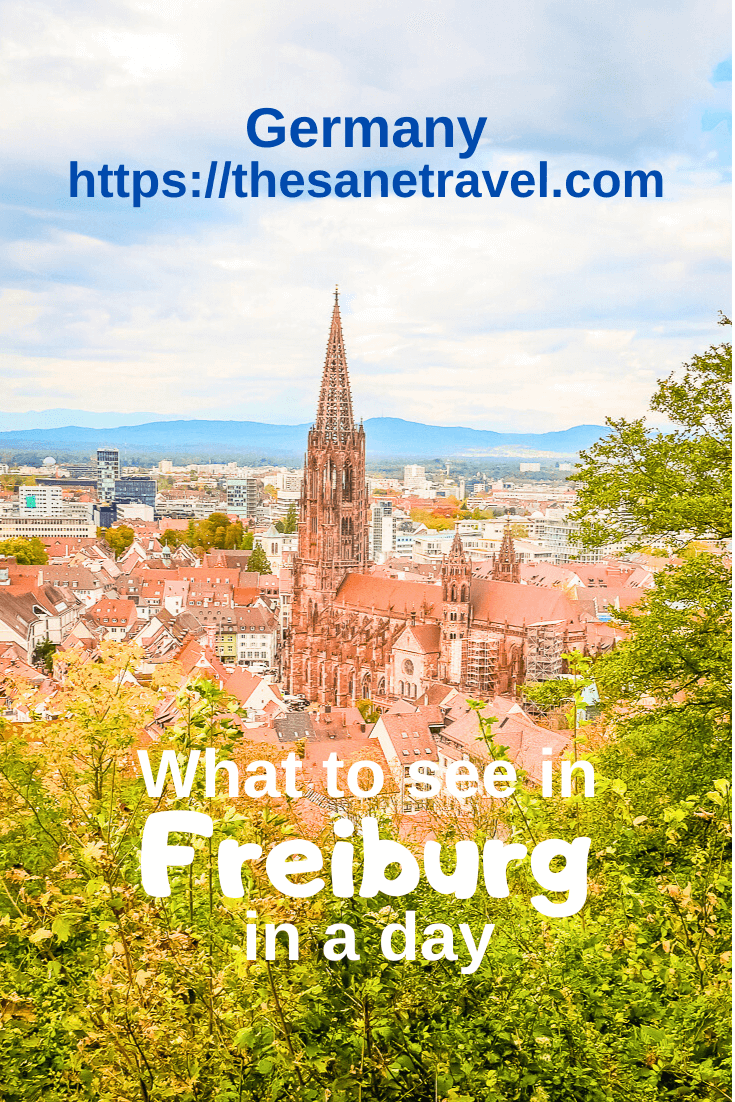
What did you think? Have you been to Freiburg? I would love to hear from you, so please add your comment below.
Author: Anita Sane

About the author
Anita is a part-time traveller, passionate photographer and a retired career woman from Latvia, travelling mostly solo for more than 15 years. She is a skilled travel planner who plans and executes her travels by herself. Anita wants to show you how to travel the world and open your mind to new experiences. Follow her on Facebook, Instagram, Pinterest, Twitter and Bloglovin.

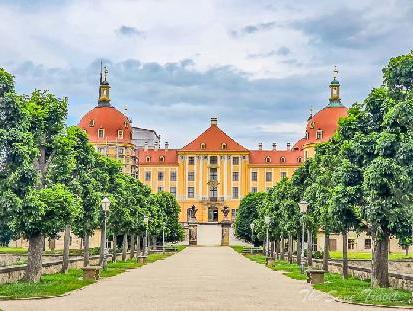
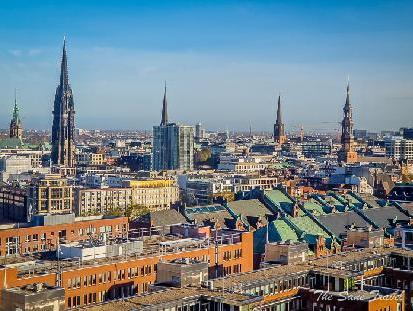
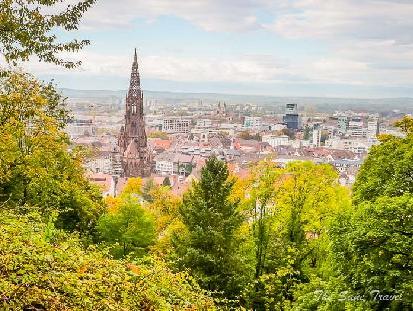
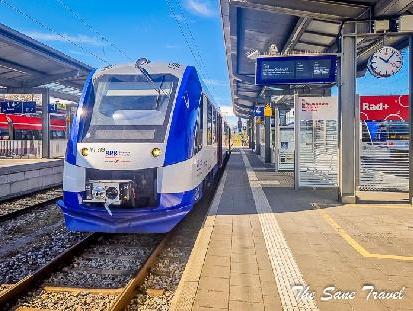
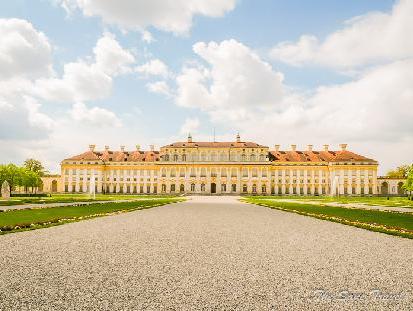
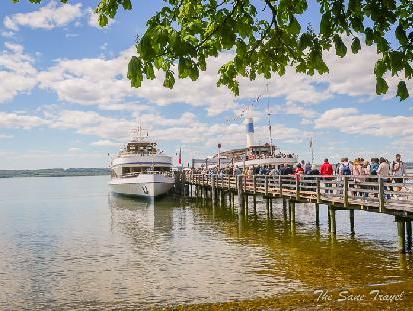
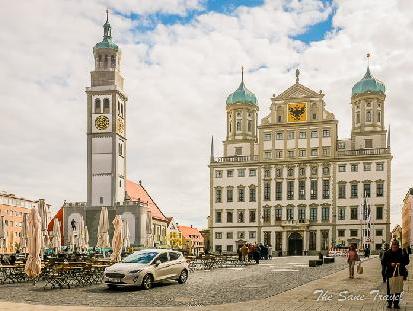
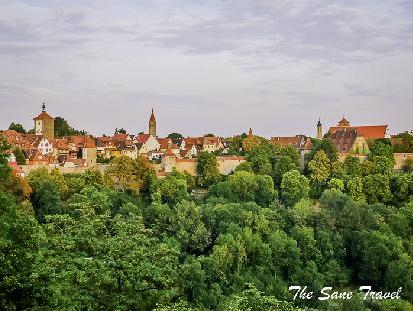
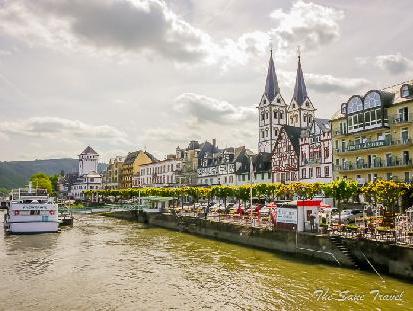
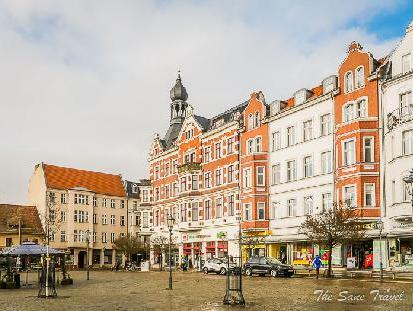
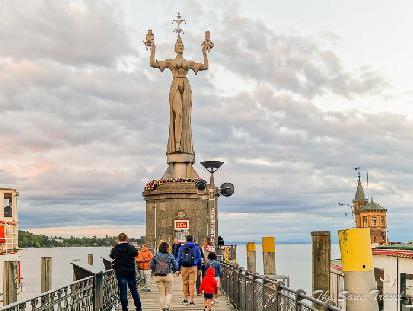
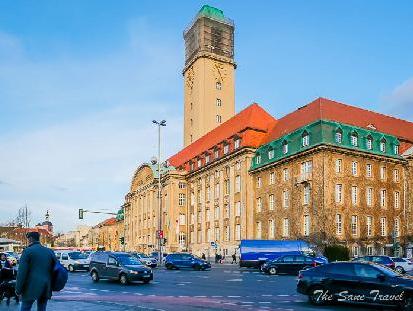
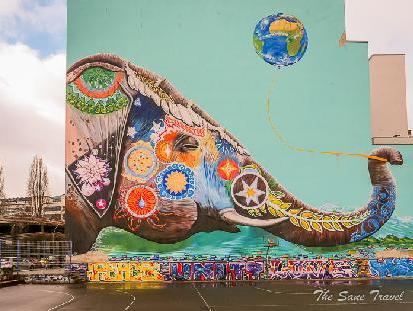
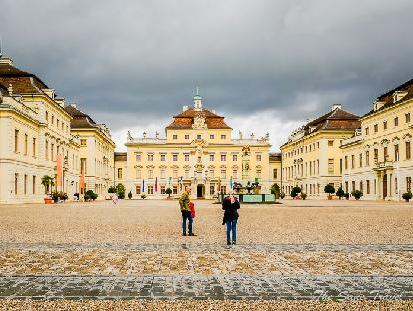
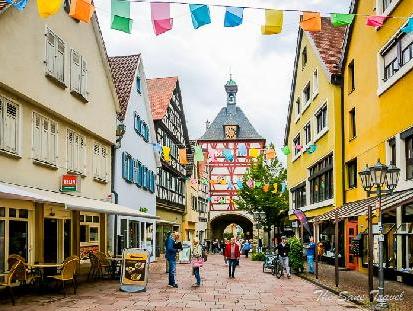
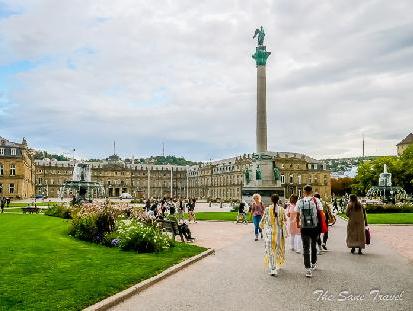
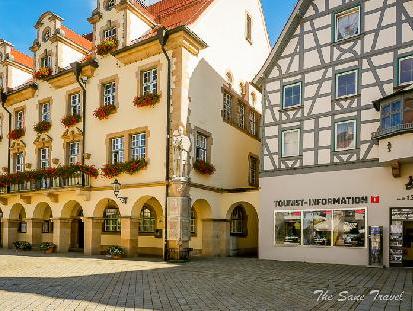
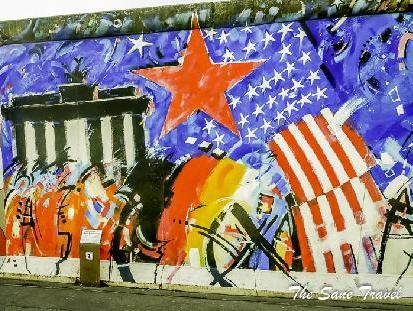
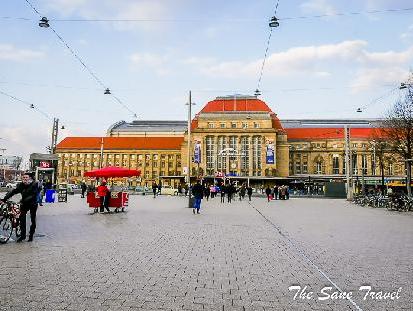
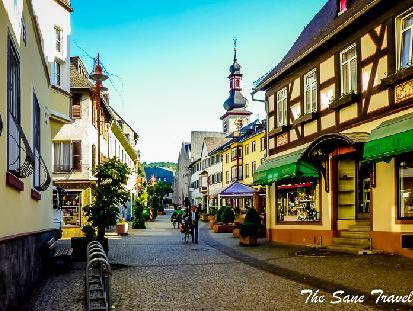
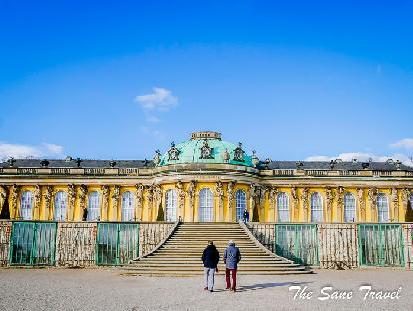
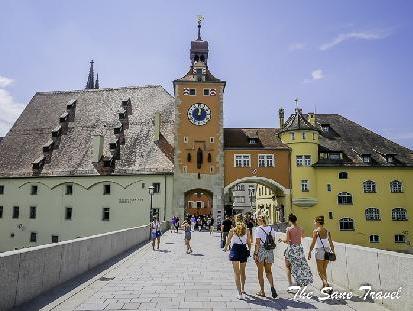
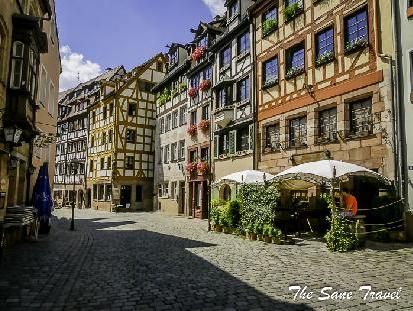
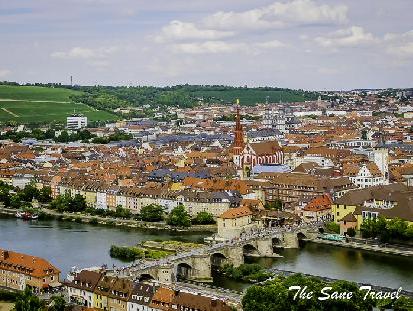
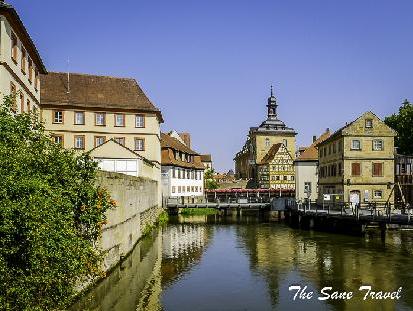
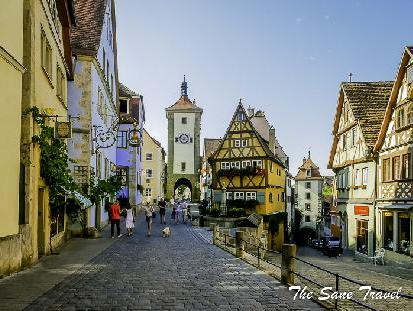
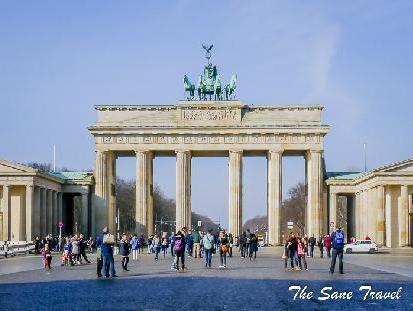
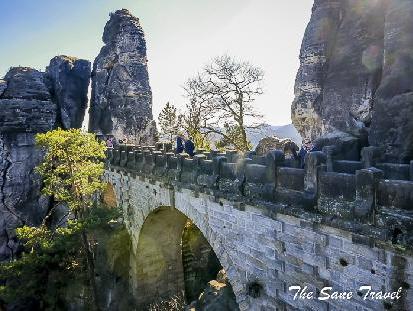
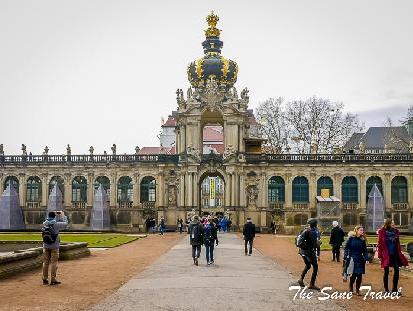
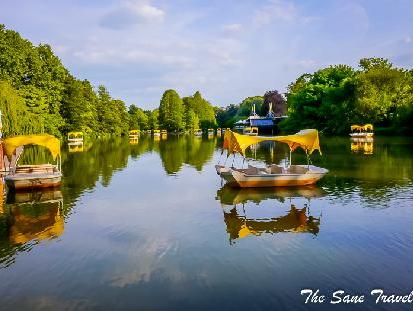
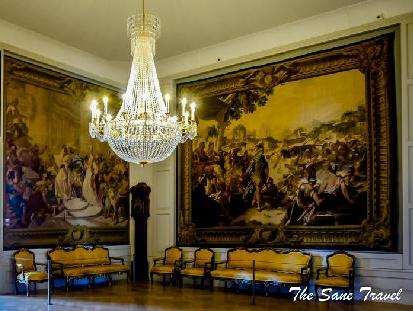
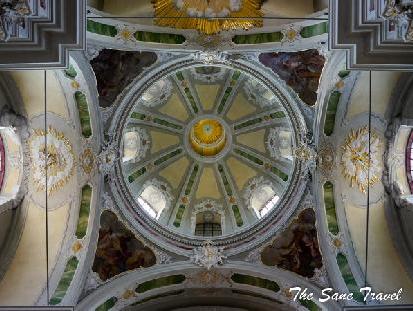
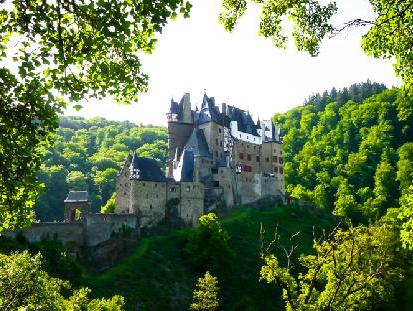
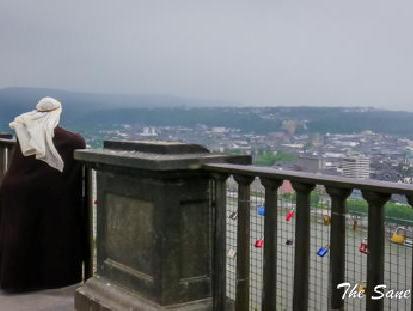
Report
My comments